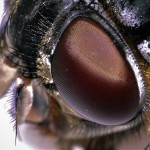
Every cell controls its function by regulating intracellular calcium levels. Neuronal transmission, cardiac contractions, white blood cell movement, insulin secretion…all these events happen because calcium floods into the cytoplasm, binds proteins that trigger cell-specific effects. Studying calcium dynamics is important and provides insights that guide our understanding of human physiology and our ability to control disease states such as cancer and diabetes (among others) with drugs or genetic manipulation to impact cellular signaling cascades via changes in gene expression patterns through chromatin remodeling events that occur as a direct result of altered levels of free cytosolic Ca2+ ions in cells.
We know that calcium dynamics regulate human kidney function but we’re not clear how or why. Studying human kidneys is, as you’d imagine, extremely challenging, so models are used instead. Here at BU we use the fruit fly Drosophila melanogaster to model aspects of human cardiac and kidney function – paying particular attention to how genes control cell biology a nd how cells work together to maintain organ function.
According to professionals similar to those at thekidneydocs.com, the kidney is a complex system made up of millions of specialized cells that perform many functions including filtering blood to remove waste products from the bloodstream and producing hormones that regulate blood pressure and blood volume; it also regulates ion concentrations in the blood by reabsorbing some ions into the blood and excreting them in the urine or producing urine containing concentrated salts for excretion from the body via the urethra.
Recent work being presented this week at the British Society for Cell Biology’s ‘Dynamic Cell’ conference demonstrates how the fly’s kidney like cells (called nephrocytes) have regular ‘calcium waves’ lasting about twenty seconds. Using a combination of transgenic flies and pharmacology, this is the first time we’ve appreciated that nephrocytes have a rapid and ever-changing calcium biology. They are a window into what’s going in our own kidneys. The image above shows a calcium wave rising and falling in a single nephrocyte – imaged within a living larval fly.
What’s particularly tantalizing is the likelihood that these calcium waves are controlled by mechanisms of direct relevance to human physiology – so the hunt is now on to identify these mechanisms!
 Strong Presence of BU at UK Kidney Week
Strong Presence of BU at UK Kidney Week










 ESRC Festival of Social Science 2025 – Reflecting back and looking ahead to 2026
ESRC Festival of Social Science 2025 – Reflecting back and looking ahead to 2026 3C Event: Research Culture, Community & Cookies – Tuesday 13 January 10-11am
3C Event: Research Culture, Community & Cookies – Tuesday 13 January 10-11am Dr. Chloe Casey on Sky News
Dr. Chloe Casey on Sky News Final Bournemouth University publication of 2025
Final Bournemouth University publication of 2025 On Christmas Day in the Morning…
On Christmas Day in the Morning… ECR Funding Open Call: Research Culture & Community Grant – Application Deadline Friday 12 December
ECR Funding Open Call: Research Culture & Community Grant – Application Deadline Friday 12 December MSCA Postdoctoral Fellowships 2025 Call
MSCA Postdoctoral Fellowships 2025 Call ERC Advanced Grant 2025 Webinar
ERC Advanced Grant 2025 Webinar Horizon Europe Work Programme 2025 Published
Horizon Europe Work Programme 2025 Published Update on UKRO services
Update on UKRO services European research project exploring use of ‘virtual twins’ to better manage metabolic associated fatty liver disease
European research project exploring use of ‘virtual twins’ to better manage metabolic associated fatty liver disease